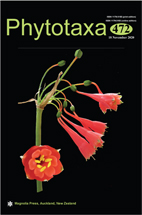Abstract
Hyphoderma etruriae is a very rare corticioid species, described originally from Italy and more recently reported from Macedonia, always growing on decayed wood of Juniperus spp. It was now found in Lisbon, on a stump of Cupressus lusitanica. Several authors have suggested that H. etruriae could be related to Hyphoderma capitatum and Hyphoderma orphanellum, and molecular analyses confirmed that these three species belong to the Hymenochaetales and are thus not closely related to Hyphoderma s. str. species. The monospecific new genus Lawrynomyces was proposed, to accommodate H. capitatum. According to multigene phylogenetic analyses (18S, 5.8S, 28S, RPB2), H. etruriae is in a well-supported clade with H. capitatum, both species sharing clampless hyphae, capitate cystidia, and an association with conifers. On the contrary, results do not support a close relationship between H. orphanellum and the H. capitatum-H. etruriae clade. The new combination Lawrynomyces etruriae is proposed, based on these results.

